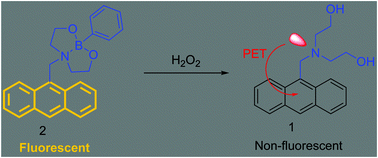Detection of hydrogen peroxide using dioxazaborocanes: elucidation of the sensing mechanism at the molecular level by NMR and XPS measurements†
Abstract
A fluorescent dioxazaborocane was synthesised and characterized, in order to study its turn-off sensing process for hydrogen peroxide detection. The exposure of the dioxazaborocane to diluted vapours of H2O2 led to a strong non reversible quenching of the fluorescence. Both NMR and XPS analyses were carried out before and after exposure of dioxazaborocane to H2O2 vapours. They unequivocally show that the boron atom is oxidised in the film with cleavage of the N–B dative bond. Identification of products such as phenol and boric acid by NMR, supported by consistent XPS data, enabled the whole reaction sequence that explains the fluorescence quenching of dioxazaborocane upon H2O2 exposure to be described accurately. Direct hydrolysis of dioxazaborocane to diol, without oxidation, was only marginally observed.



 Please wait while we load your content...
Please wait while we load your content...